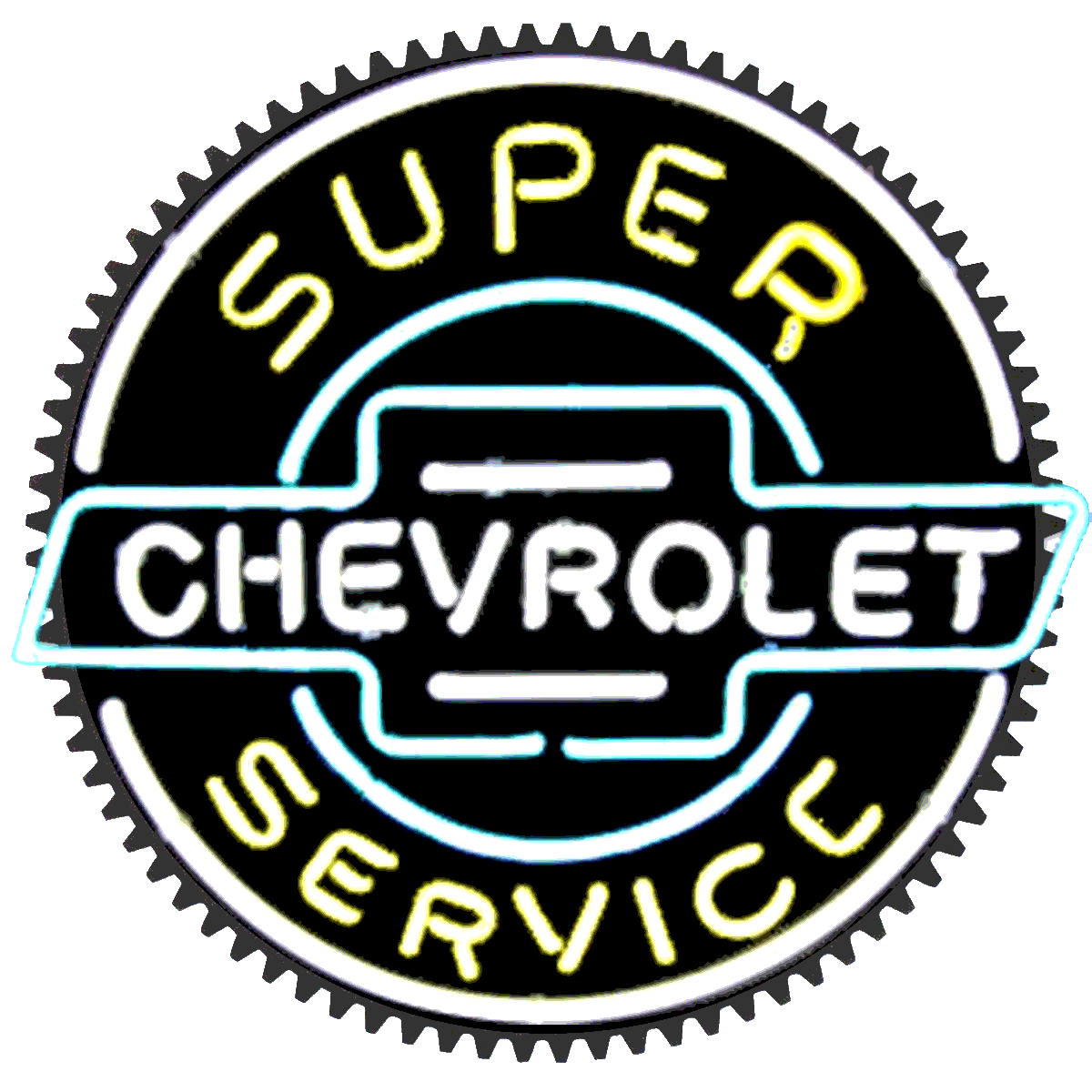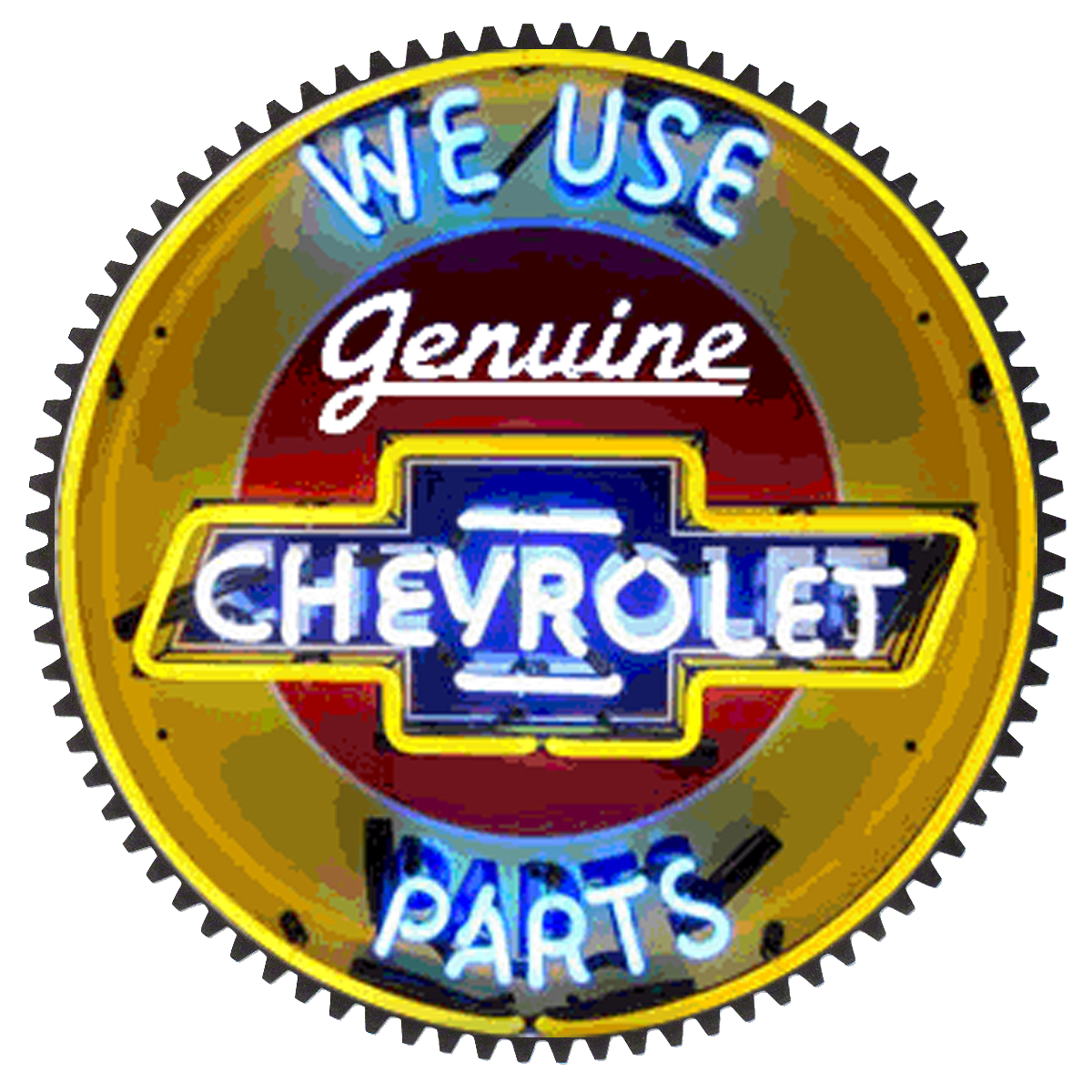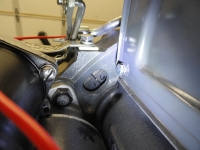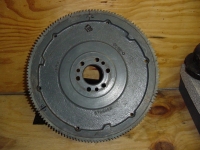Note: As with all of the content on this website, you can simply click on any picture to get its largest size. In this way, we can maintain the clearest definition to make it easier for you to see the detail. If the picture is so big you can't see all of it on your screen, all you have to do is hold down CONTROL and move the mouse wheel up and down to resize!
 Some of you have heard from other conversations people talking about 6-volt and 12-volt flywheels. This is what they are talking about: The 12 volt system was first introduced in 1955 so anything older will be a 6 volt truck. The 6 volt system was dumped because 6 volts takes twice the current (amperage) as a 12 volt system. You will notice on your 6 volt trucks the beefier wiring that was required. When GM went from 6 to 12 volts, they also reconfigured the starters. The starter drives are not interchangeable. The new design for 1955 was not only a 12 volt starter, but more teeth on the ring gear (flywheel). Since the starters have the number of teeth to compensate for the increase in flywheel teeth, they are not compatible.
Some of you have heard from other conversations people talking about 6-volt and 12-volt flywheels. This is what they are talking about: The 12 volt system was first introduced in 1955 so anything older will be a 6 volt truck. The 6 volt system was dumped because 6 volts takes twice the current (amperage) as a 12 volt system. You will notice on your 6 volt trucks the beefier wiring that was required. When GM went from 6 to 12 volts, they also reconfigured the starters. The starter drives are not interchangeable. The new design for 1955 was not only a 12 volt starter, but more teeth on the ring gear (flywheel). Since the starters have the number of teeth to compensate for the increase in flywheel teeth, they are not compatible.
 The trucks older than 1955 that have 6-volt systems require a 139-tooth ring gear of 4 teeth per inch, while the 12-volt systems that are generally associated with the newer-style 235 or 261 engine have 168 teeth, or 5 teeth per inch. When installing a new-style 235 or 261 engine in your truck, and you desire to keep the 6-volt starter, you want to make sure you keep your 216 flywheel. If you try to mate a 6-volt starter with a 12-volt ring gear, the starter drive will grind and fail to engage. The old 6-volt starter with the floor "kick switch" will work perfectly fine on a 12-volt system so this enables you to keep your starter system original.
The trucks older than 1955 that have 6-volt systems require a 139-tooth ring gear of 4 teeth per inch, while the 12-volt systems that are generally associated with the newer-style 235 or 261 engine have 168 teeth, or 5 teeth per inch. When installing a new-style 235 or 261 engine in your truck, and you desire to keep the 6-volt starter, you want to make sure you keep your 216 flywheel. If you try to mate a 6-volt starter with a 12-volt ring gear, the starter drive will grind and fail to engage. The old 6-volt starter with the floor "kick switch" will work perfectly fine on a 12-volt system so this enables you to keep your starter system original.
But let's take this conversation a bit further. Flywheels do not have teeth on them, Ring Gears do. Ring Gears are removable and with a little patience, you can even turn them over to get better teeth to engage your starter. You can even swap ring gears to get the proper tooth pattern for your starter. This is from Allen Jones, renowned stock enthusiast...

"The ring gear is removed in two ways, each at their own peril: 1) using a brass hammer (or hammer - brass drift), lightly tap the ring gear off or 2) using an acetylene torch with either a rose tip or large tip on low heat, heat the ring gear and it will fall off. If a gorilla or bull uses the hammer in method 1), it can distort the ring gear, ruining it. Note that a ring gear that’s been on the flywheel for 60-odd years will need finesse and patience in tapping until it "breaks loose". I hate using that term. With method 2), if the devil uses the torch, too much heat will distort the ring gear, ruining it. However, even heating and patience will get the ring gear off very easy."
"To put the ring gear back on, thoroughly clean both ring gear and flywheel with a wire brush. Now is the time to flip the ring gear over to engage "new" teeth. To put the ring gear back on (obviously no indexing is needed), put the ring gear in an oven at 400 degrees for about 10 to 15 minutes and it will drop right on the flywheel. Be quick! Before I had my shop oven, I used the one in the house (insert your favorite spouse joke here) and had the flywheel right outside the back door. I barely had enough time to get out the door and drop it on before it was too small (cooling = shrinkage). I always "seat" the ring gear on with a brass drift once its cooled. Some people tap the ring gear on with brass hammer, I would only use that as a very last resort (military field repair to get operational again). Everyone has an oven and a clean ring gear on top of tinfoil (or a large foil drip pan) does no harm (in my opinion)."
NOTE: Thanks for that Allen!
A 139 tooth ring gear has 138 grooves. 138 divided by 3 is exactly 46. This is handy because now we can mark our flywheel so that we know exactly when the pistons are at the top during each cycle. We will observe our markings through the timing hole on the bell housing as shown. We have had many comments from people who thank us for this idea. Especially during initial engine timing and valve adjustments.


So before installing your flywheel, get out your sharpie and mark it nicely first. You will be very glad you did when it comes time to set up your engine. Start with the BB that's embedded into the flywheel. For those of you who don't think it's there, it is, you just have to clean the flywheel enough to find it. The BB is cylinders 1 and 6. Count 46 grooves to the left and mark it 2 and 5. Count 46 grooves to the right of the BB and mark it for 3 and 4. Now count between 2/5 and 3/4 to make sure you get 46 and you did it right! Now when you turn your flywheel you can get a much better idea of what cylinders you are on. Great for static timing an engine!
If you have a newer flywheel with 168 teeth, this time divide the teeth by 3 which is 56 and do the very same thing as above. Getting to know your flywheel is essential in getting the right starter as well as setting your timing. Here are more flywheel facts concerning the business end of the flywheel from our friend Allen Jones..
Flywheels - Group 0.666. Some have 9 holes for the clutch cover and some have 6 holes (generic after markets will have all the holes). The sizes did come in 9-1/2", 10" and 11". Eleven inch flywheels came stock on Commercial Utilities and are typically considered the heavy duty version. The sizes are all mixed around on vehicles depending on what Chevrolet was trying to accomplish (which I have decided is a mystery). There are no absolutes that I can find. In fact, flywheel casting 3705410 can be a 10" or 11" flywheel. What defines it is the stamping and that seems inconsistent. For example, a lot are stamped 2 "bar" UC. The bar is vertical. Some have a delta and some have some symbol I have yet to figure out.

Clutch discs commensurately come in 9", 10", 10-1/2", and 10-3/4" diameter sizes. Plates (pressure plates) came in 9-1/2", 10", 10-1/2" and 11" inch diameters. Mix and match! One time I serviced a pickup with the 11 inch flywheel and plate with a nine inch disk. That poor clutch didn't have a chance. I suppose there was an immediate need for the pickup and a limitation of parts.
Check out the original Chevy Master Parts Catalog (1929-1954). We are all very grateful for the efforts of Keith Hardy and the folks doing the Old Car Manual Project.
More Pictures available at The Site Archive Page!
This article was first published at DevesTechNet.com (c)2015 All Rights Reserved
 Some of you have heard from other conversations people talking about 6-volt and 12-volt flywheels. This is what they are talking about: The 12 volt system was first introduced in 1955 so anything older will be a 6 volt truck. The 6 volt system was dumped because 6 volts takes twice the current (amperage) as a 12 volt system. You will notice on your 6 volt trucks the beefier wiring that was required. When GM went from 6 to 12 volts, they also reconfigured the starters. The starter drives are not interchangeable. The new design for 1955 was not only a 12 volt starter, but more teeth on the ring gear (flywheel). Since the starters have the number of teeth to compensate for the increase in flywheel teeth, they are not compatible.
Some of you have heard from other conversations people talking about 6-volt and 12-volt flywheels. This is what they are talking about: The 12 volt system was first introduced in 1955 so anything older will be a 6 volt truck. The 6 volt system was dumped because 6 volts takes twice the current (amperage) as a 12 volt system. You will notice on your 6 volt trucks the beefier wiring that was required. When GM went from 6 to 12 volts, they also reconfigured the starters. The starter drives are not interchangeable. The new design for 1955 was not only a 12 volt starter, but more teeth on the ring gear (flywheel). Since the starters have the number of teeth to compensate for the increase in flywheel teeth, they are not compatible. The trucks older than 1955 that have 6-volt systems require a 139-tooth ring gear of 4 teeth per inch, while the 12-volt systems that are generally associated with the newer-style 235 or 261 engine have 168 teeth, or 5 teeth per inch. When installing a new-style 235 or 261 engine in your truck, and you desire to keep the 6-volt starter, you want to make sure you keep your 216 flywheel. If you try to mate a 6-volt starter with a 12-volt ring gear, the starter drive will grind and fail to engage. The old 6-volt starter with the floor "kick switch" will work perfectly fine on a 12-volt system so this enables you to keep your starter system original.
The trucks older than 1955 that have 6-volt systems require a 139-tooth ring gear of 4 teeth per inch, while the 12-volt systems that are generally associated with the newer-style 235 or 261 engine have 168 teeth, or 5 teeth per inch. When installing a new-style 235 or 261 engine in your truck, and you desire to keep the 6-volt starter, you want to make sure you keep your 216 flywheel. If you try to mate a 6-volt starter with a 12-volt ring gear, the starter drive will grind and fail to engage. The old 6-volt starter with the floor "kick switch" will work perfectly fine on a 12-volt system so this enables you to keep your starter system original.But let's take this conversation a bit further. Flywheels do not have teeth on them, Ring Gears do. Ring Gears are removable and with a little patience, you can even turn them over to get better teeth to engage your starter. You can even swap ring gears to get the proper tooth pattern for your starter. This is from Allen Jones, renowned stock enthusiast...

"The ring gear is removed in two ways, each at their own peril: 1) using a brass hammer (or hammer - brass drift), lightly tap the ring gear off or 2) using an acetylene torch with either a rose tip or large tip on low heat, heat the ring gear and it will fall off. If a gorilla or bull uses the hammer in method 1), it can distort the ring gear, ruining it. Note that a ring gear that’s been on the flywheel for 60-odd years will need finesse and patience in tapping until it "breaks loose". I hate using that term. With method 2), if the devil uses the torch, too much heat will distort the ring gear, ruining it. However, even heating and patience will get the ring gear off very easy."
"To put the ring gear back on, thoroughly clean both ring gear and flywheel with a wire brush. Now is the time to flip the ring gear over to engage "new" teeth. To put the ring gear back on (obviously no indexing is needed), put the ring gear in an oven at 400 degrees for about 10 to 15 minutes and it will drop right on the flywheel. Be quick! Before I had my shop oven, I used the one in the house (insert your favorite spouse joke here) and had the flywheel right outside the back door. I barely had enough time to get out the door and drop it on before it was too small (cooling = shrinkage). I always "seat" the ring gear on with a brass drift once its cooled. Some people tap the ring gear on with brass hammer, I would only use that as a very last resort (military field repair to get operational again). Everyone has an oven and a clean ring gear on top of tinfoil (or a large foil drip pan) does no harm (in my opinion)."
NOTE: Thanks for that Allen!
A 139 tooth ring gear has 138 grooves. 138 divided by 3 is exactly 46. This is handy because now we can mark our flywheel so that we know exactly when the pistons are at the top during each cycle. We will observe our markings through the timing hole on the bell housing as shown. We have had many comments from people who thank us for this idea. Especially during initial engine timing and valve adjustments.


So before installing your flywheel, get out your sharpie and mark it nicely first. You will be very glad you did when it comes time to set up your engine. Start with the BB that's embedded into the flywheel. For those of you who don't think it's there, it is, you just have to clean the flywheel enough to find it. The BB is cylinders 1 and 6. Count 46 grooves to the left and mark it 2 and 5. Count 46 grooves to the right of the BB and mark it for 3 and 4. Now count between 2/5 and 3/4 to make sure you get 46 and you did it right! Now when you turn your flywheel you can get a much better idea of what cylinders you are on. Great for static timing an engine!
If you have a newer flywheel with 168 teeth, this time divide the teeth by 3 which is 56 and do the very same thing as above. Getting to know your flywheel is essential in getting the right starter as well as setting your timing. Here are more flywheel facts concerning the business end of the flywheel from our friend Allen Jones..
Flywheels - Group 0.666. Some have 9 holes for the clutch cover and some have 6 holes (generic after markets will have all the holes). The sizes did come in 9-1/2", 10" and 11". Eleven inch flywheels came stock on Commercial Utilities and are typically considered the heavy duty version. The sizes are all mixed around on vehicles depending on what Chevrolet was trying to accomplish (which I have decided is a mystery). There are no absolutes that I can find. In fact, flywheel casting 3705410 can be a 10" or 11" flywheel. What defines it is the stamping and that seems inconsistent. For example, a lot are stamped 2 "bar" UC. The bar is vertical. Some have a delta and some have some symbol I have yet to figure out.

Clutch discs commensurately come in 9", 10", 10-1/2", and 10-3/4" diameter sizes. Plates (pressure plates) came in 9-1/2", 10", 10-1/2" and 11" inch diameters. Mix and match! One time I serviced a pickup with the 11 inch flywheel and plate with a nine inch disk. That poor clutch didn't have a chance. I suppose there was an immediate need for the pickup and a limitation of parts.
Check out the original Chevy Master Parts Catalog (1929-1954). We are all very grateful for the efforts of Keith Hardy and the folks doing the Old Car Manual Project.
More Pictures available at The Site Archive Page!
This article was first published at DevesTechNet.com (c)2015 All Rights Reserved



 Welcome to Deves Technet.com Forums. I encourage everyone to register so we can get a better idea of the traffic and its usefulness. Please leave a word or two describing your stay and what we can do to make it more enjoyable. Thanks!
Welcome to Deves Technet.com Forums. I encourage everyone to register so we can get a better idea of the traffic and its usefulness. Please leave a word or two describing your stay and what we can do to make it more enjoyable. Thanks!